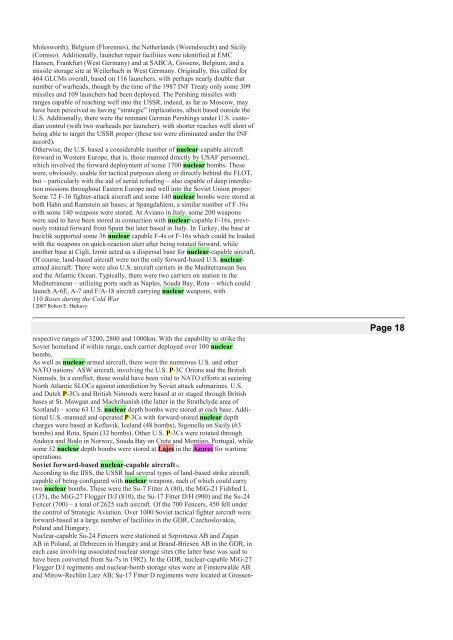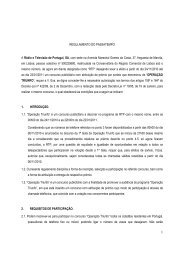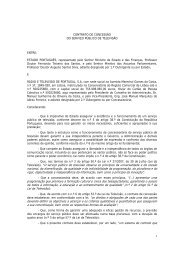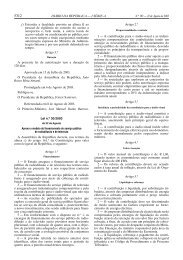6 Bases during the Cold War
6 Bases during the Cold War
6 Bases during the Cold War
You also want an ePaper? Increase the reach of your titles
YUMPU automatically turns print PDFs into web optimized ePapers that Google loves.
Molesworth), Belgium (Florennes), <strong>the</strong> Ne<strong>the</strong>rlands (Woendsrecht) and Sicily(Comiso). Additionally, launcher repair facilities were identified at EMCHansen, Frankfurt (West Germany) and at SABCA, Gossens, Belgium, and amissile storage site at Weilerbach in West Germany. Originally, this called for464 GLCMs overall, based on 116 launchers, with perhaps nearly double thatnumber of warheads, though by <strong>the</strong> time of <strong>the</strong> 1987 INF Treaty only some 309missiles and 109 launchers had been deployed. The Pershing missiles withranges capable of reaching well into <strong>the</strong> USSR, indeed, as far as Moscow, mayhave been perceived as having “strategic” implications, albeit based outside <strong>the</strong>U.S. Additionally, <strong>the</strong>re were <strong>the</strong> remnant German Pershings under U.S. custodiancontrol (with two warheads per launcher), with shorter reaches well short ofbeing able to target <strong>the</strong> USSR proper (<strong>the</strong>se too were eliminated under <strong>the</strong> INFaccord).O<strong>the</strong>rwise, <strong>the</strong> U.S. based a considerable number of nuclear-capable aircraftforward in Western Europe, that is, those manned directly by USAF personnel,which involved <strong>the</strong> forward deployment of some 1700 nuclear bombs. Thesewere, obviously, usable for tactical purposes along or directly behind <strong>the</strong> FLOT,but – particularly with <strong>the</strong> aid of aerial refueling – also capable of deep interdictionmissions throughout Eastern Europe and well into <strong>the</strong> Soviet Union proper.Some 72 F-16 fighter-attack aircraft and some 140 nuclear bombs were stored atboth Hahn and Ramstein air bases; at Spangdahlem, a similar number of F-16swith some 140 weapons were stored. At Aviano in Italy, some 200 weaponswere said to have been stored in connection with nuclear-capable F-16s, previouslyrotated forward from Spain but later based in Italy. In Turkey, <strong>the</strong> base atIncirlik supported some 36 nuclear capable F-4s or F-16s which could be loadedwith <strong>the</strong> weapons on quick-reaction alert after being rotated forward, whileano<strong>the</strong>r base at Cigli, Izmir acted as a dispersal base for nuclear-capable aircraft.Of course, land-based aircraft were not <strong>the</strong> only forward-based U.S. nucleararmedaircraft. There were also U.S. aircraft carriers in <strong>the</strong> Mediterranean Seaand <strong>the</strong> Atlantic Ocean. Typically, <strong>the</strong>re were two carriers on station in <strong>the</strong>Mediterranean – utilizing ports such as Naples, Souda Bay, Rota – which couldlaunch A-6E, A-7 and F/A-18 aircraft carrying nuclear weapons, with110 <strong>Bases</strong> <strong>during</strong> <strong>the</strong> <strong>Cold</strong> <strong>War</strong>İ 2007 Robert E. Harkavyrespective ranges of 3200, 2800 and 1000km. With <strong>the</strong> capability to strike <strong>the</strong>Soviet homeland if within range, each carrier deployed over 100 nuclearbombs.As well as nuclear-armed aircraft, <strong>the</strong>re were <strong>the</strong> numerous U.S. and o<strong>the</strong>rNATO nations’ ASW aircraft, involving <strong>the</strong> U.S. P-3C Orions and <strong>the</strong> BritishNimrods. In a conflict, <strong>the</strong>se would have been vital to NATO efforts at securingNorth Atlantic SLOCs against interdiction by Soviet attack submarines. U.S.and Dutch P-3Cs and British Nimrods were based at or staged through Britishbases at St. Mawgan and Machrihanish (<strong>the</strong> latter in <strong>the</strong> Strathclyde area ofScotland) – some 63 U.S. nuclear depth bombs were stored at each base. AdditionalU.S.-manned and operated P-3Cs with forward-stored nuclear depthcharges were based at Keflavik, Iceland (48 bombs), Sigonella on Sicily (63bombs) and Rota, Spain (32 bombs). O<strong>the</strong>r U.S. P-3Cs were rotated throughAndaya and Bodo in Norway, Souda Bay on Crete and Montigo, Portugal, whilesome 32 nuclear depth bombs were stored at Lajes in <strong>the</strong> Azores for wartimeoperations.Soviet forward-based nuclear-capable aircraft16According to <strong>the</strong> IISS, <strong>the</strong> USSR had several types of land-based strike aircraftcapable of being configured with nuclear weapons, each of which could carrytwo nuclear bombs. These were <strong>the</strong> Su-7 Fitter A (80), <strong>the</strong> MiG-21 Fishbed L(135), <strong>the</strong> MiG-27 Flogger D/J (810), <strong>the</strong> Su-17 Fitter D/H (900) and <strong>the</strong> Su-24Fencer (700) – a total of 2625 such aircraft. Of <strong>the</strong> 700 Fencers, 450 fell under<strong>the</strong> control of Strategic Aviation. Over 1000 Soviet tactical fighter aircraft wereforward-based at a large number of facilities in <strong>the</strong> GDR, Czechoslovakia,Poland and Hungary.Nuclear-capable Su-24 Fencers were stationed at Szprotawa AB and ZaganAB in Poland, at Debrecen in Hungary and at Brand-Briesen AB in <strong>the</strong> GDR, ineach case involving associated nuclear storage sites (<strong>the</strong> latter base was said tohave been converted from Su-7s in 1982). In <strong>the</strong> GDR, nuclear-capable MiG-27Flogger D/J regiments and nuclear-bomb storage sites were at Finsterwalde ABand Mirow-Rechlin Larz AB; Su-17 Fitter D regiments were located at Grossen-Page 18
















